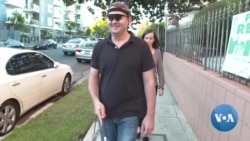ການໃຊ້ອຸປະກອນແບບໃໝ່24 ກຳລັງຊ່ວຍຄົນຕາບອດໃຫ້ສາມາດມີຄວາມຄິດກ່ຽວກັບຂອງໂລກອ້ອມຕົວຂອງເຂົາເຈົ້າແບບພື້ນຖານໄດ້ ຊຶ່ງສາມາດທີ່ຈະເຮັດໃຫ້ຄຸນນະພາບຊີວິດຂອງເຂົາເຈົ້າດີຂຶ້ນ. ນັກຂ່າວວີໂອເອ, Carol Pearson ມີລາຍລະອຽດກ່ຽວກັບເລື້ອງນີ້ ຊຶ່ງບົວສະຫວັນຈະນຳມາສະເໜີທ່ານໃນອັນດັບຕໍ່ໄປ.
ທ້າວເຈຊັນ ແອສເຕີເຮເຊັນ (Jason Esterhuizen) ຄິດວ່າລາວຈະບໍ່ສາມາດເຫັນແສງສະຫວ່າງ ຫລືການເຄື່ອນໄຫວອັນໃດໄດ້ອີກແລ້ວ ຫລັງຈາກອຸປະຕິເຫດລົດຕຳກັນເຮັດໃຫ້ລາວຕາບອດ. ແຕ່ວ່າ ກໍມີການພິກປີ້ນກັບມາ...
"ໂອ້."
ໃນທັນທີທັນໃດໂລກຂອງລາວກໍແຈ້ງສະຫວ່າງຂຶ້ນ.
ທ້າວເຈຊັນ ແອສເຕີເຮເຊັນ (Jason Esterhuizen) ທີ່ຕາບໍ່ເຫັນຮຸ່ງນັ້ນໃຫ້ຄຳເຫັນວ່າ:
"ຂ້ອຍຍັງບໍ່ສາມາດຫາຄຳເວົ້າອັນໃດດີ ທີ່ຈະມາພັນລະນາມັນໄດ້ເທື່ອ. ຂ້ອຍໝາຍຄວາມວ່າ ຈາກການທີ່ບໍ່ສາມາດເບິ່ງເຫັນໄດ້ຈັກໜ້ອຍເລີຍ ແລ້ວມັນກໍກັບປີ້ນຄືນມາໃນທັນທີທັນໃດ ກໍເຫັນພາບທີ່ເປັນແສງນ້ອຍໆ ເຄື່ອນໄຫວໄປມາຢູ່ອ້ອມໆຕົວ."
ເຖິງແມ່ນວ່າ ມັນຈະບໍ່ເປັນການເບິ່ງເຫັນໄດ້ແບບທຳມະດາກໍຕາມ, ແຕ່ວ່າ ທ້າວແອສເຕີເຮເຊັນ (Esterhuizen) ກໍສາມາດຮູ້ທິດທາງໄປມາຢູ່ໃນໂລກອ້ອມຕົວຂອງລາວງ່າຍຂຶ້ນກວ່າເກົ່າ.
ດຣ. ແນເດີ ປົວຣາຊຽນ (Nader Pouratian) ຈາກພະແນກການແພດຂອງ ມະຫາວິທະຍາໄລຄາລິຟໍເນຍໃນນະຄອນລອສ ແອນເຈີລິສ ຫລື UCLA ເວົ້າວ່າ:
"ໂດຍທີ່ສາມາດບອກໄດ້ວ່າ ປະຕູຢູ່ທາງໃດ, ສາມາດບອກໄດ້ວ່າທາງຍ່າງແຄມຖະໜົນເລີ້ມຢູ່ໃສ ແລະສຸດຢູ່ບ່ອນໃດ ແລະບ່ອນຂ້າມທາງຢູ່ໃສນັ້ນ ເປັນເລື້ອງທີ່ມີຄວາມໝາຍສຸດຂີດທັງນັ້ນເລີຍທີ່ ຊ່ວຍໃຫ້ສາມາດ ຫລືຊ່ວຍຄົນເຫລົ່ານີ້ໃຫ້ກັບມາມີຄວາມສາມາດຊ່ວຍຕົນເອງ ກຸ້ມຕົນເອງໄດ້ຄືນອີກ."
ວິທີການທີ່ມັນຊ່ວຍໄດ້ຄື: ຈັກກະຈາຍແສງອັນນ້ອຍໆ ຖືກເອົາໄປຝັງໄວ້ຢູ່ໃນ ສະໝອງ. ແລ້ວກໍມີກ້ອງຖ່າຍວີດິໂອ ຝັງໃສ່ໃນແຫວ່ນຕາກັນແດດທີ່ສົ່ງສັນຍານ ໜ່ວຍສົ່ງຕໍ່ຂໍ້ມູນ ແລ້ວກໍສົ່ງກັບມາຫາແຫວ່ນຕາກັນແດດ ທີ່ສື່ສານແບບໄຮ້ສາຍກັບສິ່ງທີ່ເອົາຝັງໄວ້ຢູ່ໃນສະໝອງນັ້ນ. ສິ່ງນີ້ໄດ້ກະຕຸ້ນໃຫ້ເກີດພາບສົ່ງໄປຍັງ ເປືອກສະໝອງສ່ວນທີ່ພາໃຫ້ເຫັນພາບ ແລະຊ່ວຍໃຫ້ຜູ້ໃຊ້ອຸປະກອນນີ້ສາມາດ ເຫັນການເຄື່ອນໄຫວ ແລະພາບຂອງແສງໄດ້.
ດຣ. ແນເດີ ປູເຣຊຽນ (Nader Pouratian) ອະທິບາຍເພີ້ມອີກວ່າ:
"ໂດຍພື້ນຖານແລ້ວ ພວກເຮົາມີກ້ອງຖ່າຍວີດິໂອ ແລະມີໜ່ວຍສົ່ງພາບວີດິໂອ ທີ່ທຳໜ້າທີ່ ຫລື ປະຕິບັດງານທີ່ໂດຍປົກກະຕິແລ້ວແມ່ນເປັນໜ້າທີ່ຂອງຕາເຮັດນັ້ນໄດ້."
ທ້າວ ແອສເຕີເຮເຊັນ (Jason Esterhuizen) ແມ່ນຜູ້ນຶ່ງໃນຈຳນວນສອງຄົນ ຢູ່ໃນສະຫະລັດ ທີ່ກຳລົງທົດລອງໃຊ້ເທັກໂນໂລຈີນີ້ຢູ່. ລາວອະທິບາຍວ່າ:
"ມັນມີຈຸດຂາວໆ ຫລາຍຈຸດຢູ່ເທິງພື້ນທີ່ສີດຳນັ້ນ. ມັນຄ້າຍຄືກັນກັບວ່າເຮົາແນມຂຶ້ນເບິ່ງດວງດາວຕ່າງໆ ຢູ່ເທິງທ້ອງຟ້າໃນຍາມກາງຄືນນີ້ຫລະ."
ເທັກໂນໂລຈີ ---ທີ່ເອີ້ນວ່າອໍໄຣອັນ (Orion) -- ໄດ້ຖືກຜະລິດຂຶ້ນມາໂດຍບໍລິສັດທີ່ຊື່ວ່າ Second Sight ຫລື ແສງຕາທີສອງ. ມັນໄດ້ຖືກທົດລອງຢູ່ໃນສູນການແພດຂອງ UCLA ແລະມະຫາວິທະຍາໄລແພດສາດ ເບເລີ (Baylor).
ໃນຂະນະທີ່ລາວຮຽນຮູ້ວ່າ ແສງທີ່ເປັນຮູບປະກາຍອອກມາແຕ່ລະອັນ ແມ່ນໝາຍເຖິງຫຍັງຢູ່ນັ້ນ ທ້າວແອສເຕີເຮເຊັນ (Esterhuizen) ກໍກຳລັງຊ່ວຍເຮັດໃຫ້ເທັກໂນໂລຈີແບບນີ້ມີປະໂຫຍດແກ່ຄົນຫລາຍຂຶ້ນ.
ທ້າວແອສເຕີເຮເຊັນ (Esterhuizen) ເວົ້າວ່າ:
"ມັນແມ່ນໃຜຜູ້ນຶ່ງກຳລັງເຄື່ອນເໜັງໄປມາຢູ່ໃນຫ້ອງ ໂດຍທີ່ຍ່າງກາຍຂ້ອຍໄປ ຫລື ຍ່າງໜີຈາກຂ້ອຍໄປ ຫລື ເປັນແສງທີ່ສາດໃສ່ຝາ. ມັນເປັນເລື້ອງທີ່ດີຢ່າງໜ້າເຫລືອເຊື່ອທີ່ມີສາຍຕາທີ່ໃຊ້ການໄດ້ແບບໃດແບບນຶ່ງຄືນອີກ."
ທ້າວແອສເຕີເຮເຊັນ (Esterhuizen) ບັດນີ້ສາມາດເລືອກເຄື່ອງໄປຊັກ ແລະເຮັດກິດຈະວັດປະຈຳວັນອື່ນໆ ຊຶ່ງເຄີຍເຮັດບໍ່ໄດ້ໃນເມື່ອກ່ອນນັ້ນ. ລາວສະແດງຄວາມຮູ້ສຶກອອກມາອີກວ່າ:
"ການຍ່າງຂ້າມທາງແມ່ນງ່າຍຂຶ້ນ ແລະປອດໄພຂຶ້ນຫລາຍ ສຳລັບຂ້ອຍ ເພາະວ່າ ຂ້ອຍສາມາດທີ່ຈະຫລຽວລົງເບິ່ງ ແລະກໍຍ່າງໄປຕາມເສັ້ນສີຂາວທີ່ທາໄວ້ຢູ່ໃນຖະໜົນນັ້ນ."
ພວກນັກຄົ້ນຄວ້າເຊື່ອວ່າ ເທັກໂນໂລຈີອັນນີ້ ມື້ນຶ່ງອາດຈະສາມາດຊ່ວຍຄົນທີ່ມີສາຍຕາບໍ່ດີຢູ່ໃນຫລາຍລະດັບ ນັບຕັ້ງແຕ່ຄົນທີ່ເປັນໂຣກຕໍ້ຫີນ ຈົນຮອດຄົນປ່ວຍເປັນໂຣກເບົາຫວານໄດ້.
ອ່ານຂ່າວນີ້ເພີ້ມເປັນພາສາອັງກິດຢູ່ຂ້າງລຸມນີ້
A new device is helping those who are blind to see. It does this in a new way by helping them experience the world around them.
Jason Esterhuizen lost his eyesight after a car accident. He never thought he would be able to see light or movement again. But now with the movement of a switch, his world suddenly grew brighter.
He says,
"I still can't put it into words. I mean from being able to see absolutely nothing, it's pitch black, to all of a sudden seeing little flickers of light move around.”
It is not full or normal sight, but Esterhuizen can move about in the world around him.
Dr. Nader Pouratian is one of the researchers at the University of California at Los Angeles Medical Center who worked on the new technology.
“Being able to tell where a doorway is, being able to tell where the sidewalk begins or ends or where the crosswalk is, are all extremely meaningful events that can help these people regain some form of independence.
The new technology uses several parts. One is a small device placed in the brain. The other parts are a video camera on sunglasses and a processing device that can be carried in a person’s clothes. When the user points the camera, a signal goes to the processor and then back to the glasses. The glasses then communicate wirelessly with the device in the brain. The information causes a pattern to develop in the part of the brain called the visual cortex. The pattern helps users detect, or see, movement and shapes of light. And it all happens in seconds.
Pouratian says this technology is a first.
“We basically have the video camera and the video processing unit functioning or performing the functions of what the eye normally does.”
Esterhuizen is one of just two people in the U.S. testing this technology. He describes what he sees.
“There's little white dots on a black background. It's like looking up at the stars at night.”
The technology — called Orion — is manufactured by a company called Second Sight. It's being tested at the UCLA Medical Center in California and the Baylor College of Medicine in Texas.
Esterhuizen says the results are amazing.
“Someone moving across the room, walking past me or walking away from me, or it's a light against the wall. It was just amazing to have some form of functional vision again.”
He adds that now he can do everyday activities around his home that he once could not. It is easier to walk outside.
"Crossing the road is much easier and much safer for me because I can look down and just follow the white line that's painted on the road.”
The researchers believe that one day this technology could help people who have lost their vision because of illnesses like glaucoma or diabetes. It may also help those with poor vision or who were born blind.
I’m Anne Ball.
Carol Pearson wrote this story for VOA News. Anne Ball adapted it for VOA Learning English.
What do you think of this story? We want to hear from you. Write to us in the Comments Section.
________________________________________________________________
Words in This Story
switch - n. a small device that starts or stops the flow of electricity to something (such as a lamp or a machine) when it is pressed or moved up and down
pitch black – adj. completely dark
flickers – n. (plural) a quick and unsteady movement of light
sidewalk – n. a usually concrete path along the side of a street for people to walk on
crosswalk – n. a marked path where people can safely walk across a street or road
pattern – n. a repeated form or design especially that is used to decorate something






